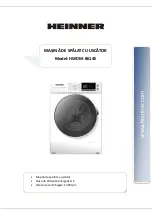
Revised: A-07/09/2021
Part #: 7109-111-001
Page 3 of 4
Operation
4. When finished return the push paddle to the
vertical or fully “OFF” position. Flushing fluid
should stop. Once flushing fluid has stopped
flowing, return spray nozzle lids to the closed
position to protect from airborne contaminates.
1. To start the Eye Wash, push the paddle forward
to the horizontal or fully “ON” position. Flushing
should start, popping the spray nozzle caps
open.
2. Lower both eyes into flow. Both eyes should be
flushed to prevent contamination from one eye
from being delivered to unaffected eye.
Personnel who wear contact lenses should
remove them immediately prior to or during the
flush to prevent the contamination from
remaining against the cornea possibly causing
unnecessary damage or pain.
3. Using thumb and forefingers, fully open eyelids
and flush eyes thoroughly for approximately 15
minutes or until medical personnel arrive. Be
prepared to let the doctor know what type of
contamination has entered the eye.
1. Check for obvious signs of wear, broken or
defective equipment. Re-paint if necessary.
Replace missing or defective equipment such as
broken push paddles, missing signs and
inspection tags.
Maintain and inspect in accordance with ANSI
Z358.1-2014
2. Operate Eye Wash nozzles using the push
paddle to place ball valve in the fully “ON”
position checking for smooth operation of valve
push paddle mechanism at the same time
ensuring that the Eye Wash spray nozzle caps
pop off immediately when actuated. If the ball
valve does not operate smoothly check the
actuating assembly for binding or missing parts.
If the Eye Wash spray nozzle caps do not pop
off immediately when actuated check for correct
supply inlet pressure.
4. Return push paddle to vertical or fully “OFF”
position and swing back to stand by position. To
prevent Eye Wash spray nozzles from becoming
contaminated, always close nozzle lids after
each use.
3. While in operation, inspect spray nozzles for
clogs or debris correct or replace as required.
Installation & Operation Manual
Acorn Safety
a division of Acorn Engineering Company™
4. Reassemble Eye Wash/ Valve Assembly to keg
with the necessary attachments to secure unit.
Pressurize tank to 80 PSI using a compressor or
related device.
A waterproof Test Card to record the date and
inspector's name is provided.
It is recommended
that the eyewash be visually inspected weekly for
inadequate water level. Inspections which give
evidence of any “particulate matter” or
discoloration suggest the water be replaced
immediately.
Employees who work with hazardous materials
should become familiar with the location and
operation of the nearest emergency plumbing
station. Portable emergency plumbing stations are
simple to use and require hands free operation
once the station is activated. Regular instruction
regarding proper care and use will increase
confidence that the units are accessible and
function properly.
The route and area surrounding the Eye Wash
should be clear and unobstructed; the sooner eyes
are flushed, the less likelihood of damage.
Portable Eye Wash stations should be located in
close proximity to the hazard and take no more
than 10 seconds to reach. In the case of severe
eye contamination the victim may require
assistance to the Eye Wash station and help
flushing their eyes.
To operate unit, fill with 10 gallons clean potable
water and add water preservative (by others).
Preservative protects against growth of bacteria,
fungus and algae. After filling with water,
pressurize unit to 80 PSI. Unit should be visually
inspected weekly and water should be changed at
least once every six months.
Filling the Tank
1. Relieve pressurized keg by pulling the ring
attached to the pressure relieve valve until
pressure gauge reads 0 PSI.
2. Remove Eye Wash/ Valve Assembly and set
aside, then dump remaining contents of keg. If
necessary, clean the inside of the tank using
warm water and mild soap. Rinse thoroughly
with warm water.
3. Refill keg with 10 gallons of potable water and
add water preservative (recommended).
OPERATION INSTRUCTIONS:
Weekly Inspection
OPERATION AND MAINTENANCE






















